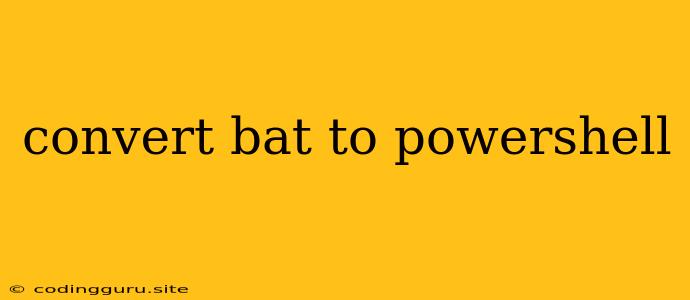Converting Batch (.bat) Files to PowerShell (.ps1)
Many Windows users are familiar with batch files (.bat) and their simple, yet effective scripting capabilities. However, as more complex automation tasks arise, the limitations of batch files become apparent. This is where PowerShell steps in, offering a more powerful and versatile scripting language for Windows administration.
Converting a batch file to PowerShell is a straightforward process, but it involves understanding the differences between the two languages. Here's a comprehensive guide to help you navigate the conversion:
Why Convert Batch Files to PowerShell?
- Enhanced Functionality: PowerShell offers a wider range of cmdlets (PowerShell commands) for managing Windows systems, including advanced features like object manipulation and remote management.
- Error Handling: PowerShell provides robust error handling mechanisms, making it easier to debug and troubleshoot scripts.
- Object-Oriented Programming: PowerShell leverages object-oriented concepts, enabling efficient data management and complex logic.
- Cross-Platform Compatibility: While primarily associated with Windows, PowerShell is now available on Linux and macOS, offering greater portability for your scripts.
Steps to Convert a Batch File to PowerShell
- Identify the Batch File Commands: Open your batch file and carefully examine the commands used. Understand their functionality and how they relate to PowerShell equivalents.
- Research PowerShell Alternatives: For each batch command, research the corresponding PowerShell cmdlet. Numerous resources, including Microsoft documentation and online forums, can guide you through this process.
- Rewrite the Script: Create a new PowerShell script file (.ps1) and start translating the batch commands one by one. Remember to use the correct syntax and parameter names for PowerShell cmdlets.
- Test the Script: Thoroughly test the converted PowerShell script to ensure it functions as intended. Pay close attention to error messages and debug accordingly.
Example Conversion:
Let's take a simple example of a batch file that displays "Hello World!" in a message box:
@echo off
echo Hello World! > message.txt
msg * "Hello World!"
Here's how you'd convert this to PowerShell:
# Disable echoing of commands to the console
$ErrorActionPreference = "SilentlyContinue"
# Create a text file and write "Hello World!" to it
Out-File -FilePath "message.txt" -InputObject "Hello World!"
# Display a message box with "Hello World!"
# Note: This might require the 'Windows.UI.Notifications' module
# to be installed and imported
[Windows.UI.Notifications.ToastNotificationManager]::CreateToastNotifier().Show([Windows.UI.Notifications.ToastNotification]::CreateToastNotification(
[Windows.UI.Notifications.ToastNotificationManager]::GetTemplateContent(Windows.UI.Notifications.ToastTemplateType.ToastText01)).SetContent(
[Windows.UI.Notifications.ToastNotificationManager]::GetTemplateContent(Windows.UI.Notifications.ToastTemplateType.ToastText01).GetElementsByTagName('text')[0],
'Hello World!'
)))
Tips for Conversion:
- Use PowerShell's
Get-Helpcmdlet: For any unfamiliar cmdlet, useGet-Help cmdlet_nameto access its documentation. - Break Down Complex Tasks: If your batch file performs multiple actions, consider breaking it down into smaller, more manageable PowerShell functions.
- Embrace Object Manipulation: Utilize PowerShell's object-oriented nature to efficiently manage data and improve code clarity.
- Test Regularly: Throughout the conversion process, test your code frequently to identify and fix any issues early on.
Conclusion
Converting batch files to PowerShell offers a significant upgrade in terms of functionality, error handling, and scripting capabilities. By following the steps outlined above and utilizing available resources, you can seamlessly migrate your batch scripts to PowerShell and unlock its full potential for managing and automating your Windows systems.
